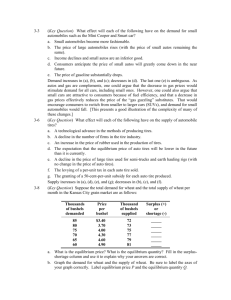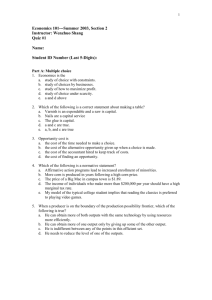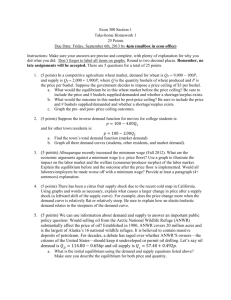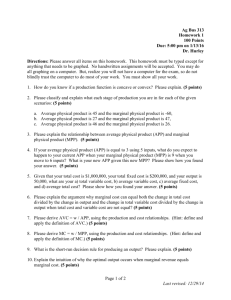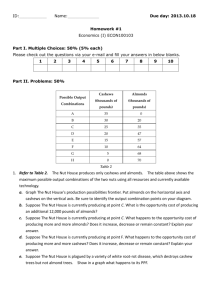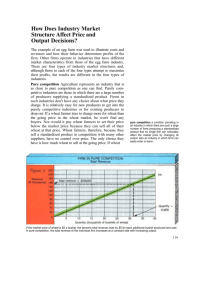Supply, Demand, and Equilibrium
advertisement
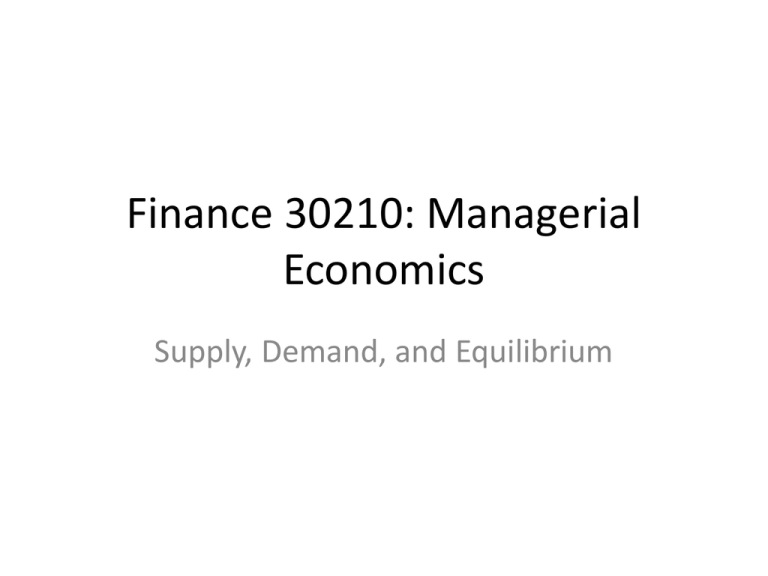
Finance 30210: Managerial Economics Supply, Demand, and Equilibrium Suppose that you are the “Wheat Czar”. You are asked to use the three farmers to produce 15 bushels of wheat as cheaply as possible. Farmer #1 Farmer #2 Farmer #3 Bushels of Wheat Total Cost Bushels of Wheat Total Cost Bushels of Wheat Total Cost 1 $2 1 $3 1 $1 2 $5 2 $7 2 $3 3 $9 3 $12 3 $6 4 $14 4 $18 4 $10 5 $20 5 $25 5 $15 6 $27 6 $33 6 $21 7 $35 7 $42 7 $28 You decide that farmers 1 and 3 are the cheapest so you have them produce as much as possible and then have farmer 2 make up the rest. Could you do better? TC $28 $35 $3 $66 Suppose that you are the “Wheat Czar”. You are asked to use the three farmers to produce 15 bushels of wheat as cheaply as possible. Farmer #1 Farmer #2 Farmer #3 Bushels of Wheat Total Cost Bushels of Wheat Total Cost Bushels of Wheat Total Cost 1 $2 1 $3 1 $1 2 $5 2 $7 2 $3 3 $9 3 $12 3 $6 4 $14 4 $18 4 $10 5 $20 5 $25 5 $15 6 $27 6 $33 6 $21 7 $35 7 $42 7 $28 By having farmer #2 scale up by one bushel, you spend $4 By having farmer #3 scale back by one bushel, you save $7 TC $21 $35 $7 $63 The same 15 bushels are produced at a net $3 savings! Average Cost vs. Marginal Cost Average Cost is simply the total cost divided by quantity produced Marginal Cost refers to the additional costs incurred by producing on more unit Consider the following farmer: Bushels of Wheat Total Cost 1 $2 2 $5 3 $9 4 $14 5 $20 6 $27 7 $35 AC MC TC $14 $3.50 Q 4 TC $14 $9 $5 Q 43 Bushels of Wheat Total Cost Average Cost Marginal Cost 1 $2 $2 $2 2 $5 $2.50 $3 3 $9 $3 $4 4 $14 $3.50 $5 5 $20 $4 $6 6 $27 $4.50 $7 7 $35 $5 $8 Suppose that you are the ‘Wheat Czar”. You are asked to use the three farmers to produce 15 bushels of wheat as cheaply as possible. The efficient (lowest cost solution) is where marginal costs are equal across all producers. Farmer #1 Farmer #2 Farmer #3 Bushels of Wheat Marginal Cost Bushels of Wheat Marginal Cost Bushels of Wheat Marginal Cost 1 $2 1 $3 1 $1 2 $3 2 $4 2 $2 3 $4 3 $5 3 $3 4 $5 4 $6 4 $4 5 $6 5 $7 5 $5 6 $7 6 $8 6 $6 7 $8 7 $9 7 $7 TC $20 $18 $21 $59 Suppose that rather than choosing what each farmer grows you make the offer ‘I will buy any wheat produced for $6”. Farmer #1 Bushels of Wheat Total Revenue (P*Q) Total Cost Profit 1 $6 $2 $4 2 $12 $5 $7 3 $18 $9 $9 4 $24 $14 $10 5 $30 $20 $10 6 $36 $27 $9 7 $42 $35 $7 At a $6 price, Farmer #1 would choose to produce 5 bushels as a profit maximizing decision. (P=MC) Farmer #1’s decision is not only individually optimal, but socially optimal (efficient) as well!! Further, this solution requires no information on individual farmers’ At a stated market price of $4, each farmer chooses to produce up to the point where P=MC Farmer #1 Farmer #2 Farmer #3 Market Supply Bushels of Wheat Marginal Cost Bushels of Wheat Marginal Cost Bushels of Wheat Marginal Cost Market Price Total Supply 1 $2 1 $3 1 $1 $1 1 2 $3 2 $4 2 $2 $2 3 3 $4 3 $5 3 $3 $3 6 4 $5 4 $6 4 $4 $4 9 5 $6 5 $7 5 $5 $5 12 6 $7 6 $8 6 $6 $6 15 7 $8 7 $9 7 $7 $7 18 The market supply function simply adds up the decisions of each farmer at each potential market price A Supply Function represents the rational decisions made by a representative firm(s) “Is a function of” QS S P Quantity Supplied Market Price (+) Market Supply Market Price Total Supply $1 1 $2 3 $3 6 $4 9 $5 12 $6 15 $7 18 Price S $6.00 $4.00 9 15 Bushels of Wheat Now, as “Wheat Czar” you have 15 bushels of wheat to distribute amongst your citizens. To whom do you give the wheat? Citizen #1 Citizen #2 Citizen #3 Bushels of Wheat Marginal Value Bushels of Wheat Marginal Value Bushels of Wheat Marginal Value 1 $18 1 $10 1 $14 2 $16 2 $8 2 $12 3 $14 3 $6 3 $10 4 $12 4 $4 4 $8 5 $10 5 $2 5 $6 6 $8 6 $1 6 $4 7 $6 7 $0 7 $2 Total Value = $84 Total Value = $10 Total Value = $56 Note: Marginal value is the dollar amount each citizen is willing to pay for each additional bushel of wheat Total = $150 Suppose we started out with citizens 1 and 3 getting 7 bushels each and citizen 2 getting one. We could do better, right? Now, as “Wheat Czar” you have 15 bushels of wheat to distribute amongst your citizens. To whom do you give the wheat? Citizen #1 Citizen #2 Citizen #3 Bushels of Wheat Marginal Value Bushels of Wheat Marginal Value Bushels of Wheat Marginal Value 1 $18 1 $10 1 $14 2 $16 2 $8 2 $12 3 $14 3 $6 3 $10 4 $12 4 $4 4 $8 5 $10 5 $2 5 $6 6 $8 6 $1 6 $4 7 $6 7 $0 7 $2 Total Value = $84 Total Value = $18 Total Value = $54 Note: Marginal value is the dollar amount each citizen is willing to pay for each additional bushel of wheat Total = $156 By taking a bushel from #3 and giving it to #2, we get a net gain of $6 (A loss of $2 by #3 and a gain of $8 by #2) Now, as “Wheat Czar” you have 15 bushels of wheat to distribute amongst your citizens. To whom do you give the wheat? Citizen #1 Citizen #2 Citizen #3 Bushels of Wheat Marginal Value Bushels of Wheat Marginal Value Bushels of Wheat Marginal Value 1 $18 1 $10 1 $14 2 $16 2 $8 2 $12 3 $14 3 $6 3 $10 4 $12 4 $4 4 $8 5 $10 5 $2 5 $6 6 $8 6 $1 6 $4 7 $6 7 $0 7 $2 Total Value = $84 Total Value = $24 Total Value = $50 As with the farmers, the best allocation is where values by all citizens (at the margin) are equal. Total = $158 By taking a bushel from #3 and giving it to #2, we get a net gain of $6 (A loss of $2 by #3 and a gain of $8 by #2) – As with the producers, announcing “I will sell wheat at $6/ bushel” would accomplish the same thing! At a market price of, say $6, each buyer decides how much to purchase Citizen #1 Citizen #2 Citizen #3 Bushels of Wheat Marginal Value Bushels of Wheat Marginal Value Bushels of Wheat Marginal Value Market Price Bushels of Wheat 1 $18 1 $10 1 $14 $2 19 2 $16 2 $8 2 $12 $4 17 3 $14 3 $6 3 $10 $6 15 4 $12 4 $4 4 $8 $8 12 5 $10 5 $2 5 $6 $10 9 6 $8 6 $1 6 $4 $12 6 7 $6 7 $0 7 $2 $14 4 The market demand function simply adds up the decisions of each citizen at each potential market price A Demand Function represents the rational decisions made by a representative consumer(s) Quantity Demanded “Is a function of” QD DP Market Price (-) Market Price Bushels of Wheat $2 19 $4 17 $6 15 $8 12 $10 9 $12 6 $14 4 Price $10 $6 D Quantity 9 15 Farmer #1 Farmer #2 Farmer #3 Market Supply Bushels of Wheat Marginal Cost Bushels of Wheat Marginal Cost Bushels of Wheat Marginal Cost Market Price Bushels of Wheat 1 $2 1 $3 1 $1 $1 1 2 $3 2 $4 2 $2 $2 3 3 $4 3 $5 3 $3 $3 6 4 $5 4 $6 4 $4 $4 9 5 $6 5 $7 5 $5 $5 12 6 $7 6 $8 6 $6 $6 15 7 $8 7 $9 7 $7 $7 18 An announcement of “ I will buy and sell at $6” Gets the job done! Citizen #1 Citizen #2 Citizen #3 Market Demand Bushels of Wheat Marginal Value Bushels of Wheat Marginal Value Bushels of Wheat Marginal Value Market Price Bushels of Wheat 1 $18 1 $10 1 $14 $2 19 2 $16 2 $8 2 $12 $4 17 3 $14 3 $6 3 $10 $6 15 4 $12 4 $4 4 $8 $8 12 5 $10 5 $2 5 $6 $10 9 6 $8 6 $1 6 $4 $12 6 7 $6 7 $0 7 $2 $14 4 There is no need to even set the price. The market will find the $6 price on its own! Price S Market Demand Market Supply Market Price Bushels of Wheat Market Price Bushels of Wheat $2 19 $1 1 $4 17 $2 3 $6 15 $3 6 $8 12 $4 9 $10 9 $5 12 $12 6 $6 15 $14 4 $7 18 $6 D Quantity 15 We would call the $6 price the equilibrium price A market price below the equilibrium price would create a shortage! Market Supply Market Demand Market Price Bushels of Wheat Market Price Bushels of Wheat $1 1 $2 19 $2 3 $4 17 $3 6 $6 15 $4 9 $8 12 $5 12 $10 9 $6 15 $12 6 $7 18 $14 4 Price S $2.00 D At a price of $2.00, total supply is 3, but demand is at least 19 Quantity 3 19 A market price above the equilibrium price would create a surplus! Market Supply Market Demand Market Price Bushels of Wheat Market Price Bushels of Wheat $1 1 $2 19 $2 3 $4 17 $3 6 $6 15 $4 9 $8 12 $5 12 $10 9 $6 15 $12 6 $7 18 $14 4 $8 20 S Price $8.00 At a price of $8.00, total supply is 20, but demand is less than 12 D Quantity 12 20 Note that citizen #1 would’ve paid up to $14 for the third bushel of wheat, but was only charged $6 in the marketplace. The $8 difference is referred to as consumer surplus Price S $14 Citizen #1 Bushels of Wheat Marginal Value Consumer Surplus 1 $18 $12 2 $16 10 3 $14 $8 4 $12 $6 5 $10 $4 6 $8 $2 7 $6 $0 $8 $6 Total = $42 D Quantity 3 15 Also, note that Farmer #1 would’ve sold that 3rd bushel of wheat for as low as $4. The difference a producers marginal cost and the market price is referred to as producer surplus. Price S $6 Farmer #1 Bushels of Wheat Marginal Cost Producer Surplus 1 $2 $4 2 $3 $3 3 $4 $2 4 $5 $1 5 $6 $0 6 $7 --- 7 $8 --- Total = $10 $2 $4 D Quantity 3 15 Farmer #1 Farmer #2 Farmer #3 Bushels of Wheat Marginal Cost Producer Surplus Bushels of Wheat Marginal Cost Producer Surplus Bushels of Wheat Marginal Cost Producer Surplus 1 $2 $4 1 $3 $3 1 $1 $5 2 $3 $3 2 $4 $2 2 $2 $4 3 $4 $2 3 $5 $1 3 $3 $3 4 $5 $1 4 $6 $0 4 $4 $2 5 $6 $0 5 $7 $--- 5 $5 $1 6 $7 $--- 6 $8 $--- 6 $6 $0 7 $8 $--- 7 $9 $--- 7 $7 $--- Total = $10 Citizen #1 Total = $6 Total = $15 Citizen #2 Citizen #3 Bushels of Wheat Marginal Value Consumer Surplus Bushels of Wheat Marginal Value Consumer Surplus Bushels of Wheat Marginal Value Consumer Surplus 1 $18 $12 1 $10 $4 1 $14 $8 2 $16 10 2 $8 $2 2 $12 $6 3 $14 $8 3 $6 $0 3 $10 $4 4 $12 $6 4 $4 $--- 4 $8 $2 5 $10 $4 5 $2 $--- 5 $6 $0 6 $8 $2 6 $1 $--- 6 $4 $--- 7 $6 $0 7 $0 $--- 7 $2 $--- Total = $42 Total = $6 Total = $20 A competitive marketplace maximizes the total consumer plus producer surplus. An efficient outcome! Price S Consumer Surplus Producer Surplus $42 $10 $6 $6 $20 $15 Total = $68 Total = $31 Total = $99 $68 $31 D Quantity 15 Example: Suppose we have the following petroleum firms. Further suppose that there is pressure from the public to reduce pollution levels. Firm Historical Emissions (Tons/yr) Marginal Abatement Cost ($/Ton) Apache 50 12 BP 50 18 Chevron 50 24 Devon 50 30 Exxon 50 36 First Texas 50 42 Gulf 50 48 Hess 50 54 Industry Total 400 How would you go about reducing emissions by 50% The cheapest way to reduce pollution by 50% would be to require the cheapest 4 firms to reduce their emissions completely and let the other four firms continue as in the past $ Per Unit Pollution Reduction Hess $54 Gulf $48 First $42 Exxon $36 Devon $30 Chevron $24 BP $18 $12 Problems: •Unfair •Requires information on abatement costs Apache Quantity of Emissions Reduction We could follow an “across the board” emission reduction program (note: pollution taxes would have the same basic effect) Firm Historical Emissions (Tons/yr) Marginal Abatement Cost ($/Ton) Tons of emission to be reduced Total abatement cost Apache 50 12 25 300 BP 50 18 25 450 Chevron 50 24 25 600 Devon 50 30 25 750 Exxon 50 36 25 900 First Texas 50 42 25 1,050 Gulf 50 48 25 1,200 Hess 50 54 25 1,350 Industry Total 400 200 6,600 Let markets work for you!!! Example: Cap and Trade as a solution to pollution reduction. Firm Historical Emissions (Tons/yr) Marginal Abatement Cost ($/Ton) Apache 50 12 BP 50 18 Chevron 50 24 Devon 50 30 Exxon 50 36 First Texas 50 42 Gulf 50 48 Hess 50 54 Industry Total 400 Could BP profit from selling a pollution permit to Gulf? What should the selling price be? The Market for pollution permits $ Per Unit Pollution Reduction $54 Hess Gulf $48 Equilibrium price range Hess Gulf First $42 S $36 First Exxon Exxon Devon Devon $33 $30 Chevron $24 BP $18 $12 Apache Chevron BP Apache D Quantity of Emissions Reduction The cap and trade program lowered the cost of pollution reduction by $2,400 (from $6,600 to $4,200). Firm Historical Emissions (Tons/yr) Marginal Abatement Cost ($/Ton) Initial Permit Holdings Permits Sold Permits Bought Final Permit Holdings Required Emission Reduction Emission Abatement Cost Apache 50 12 25 25 0 0 50 $600 BP 50 18 25 25 0 0 50 $900 Chevron 50 24 25 25 0 0 50 $1200 Devon 50 30 25 25 0 0 50 $1500 Exxon 50 36 25 0 25 50 0 $0 First Texas 50 42 25 0 25 50 0 $0 Gulf 50 48 25 0 25 50 0 $0 Hess 50 54 25 0 25 50 0 $0 Industry Total 400 200 100 100 400 200 $4,200 Note that cost of purchasing permits equals revenues from selling permits and so add so additional costs. Lets set the equilibrium permit price at $33. Firm Initial Pollution Reduction Final Pollution Requirement Marginal Abatement Cost ($/Ton) Abatement Cost Additions/ Savings Permits Bought Permits Sold Permit Cost/Permit Revenue Net Gain Apache 25 50 (+25) 12 $300 0 25 -$825 -$525 BP 25 50 (+25) 18 $450 0 25 -$825 -$375 Chevron 25 50 (+25) 24 $600 0 25 -$825 -$225 Devon 25 50 (+25) 30 $750 0 25 -$825 -$75 Exxon 25 0 (-25) 36 -$900 25 0 $825 -$75 First Texas 25 0 (-25) 42 -$1050 25 0 $825 -$225 Gulf 25 0 (-25) 48 -$1200 25 0 $825 -$375 Hess 25 0 (-25) 54 -$1350 25 0 $825 -$525 Industry Total 200 200 -$2,400 200 200 $0 -$2,400 The consumer/producer surplus represents the gains by all firms $ Per Unit Pollution Reduction $54 Hess Hess Gulf $48 S Gulf $525 First $42 First $375 $225 Exxon $36 Exxon $75 $33 $30 $225 Devon Devon $375 $24 Chevron $525 Chevron $75 BP $18 $12 Apache BP Apache D Quantity of Emissions Reduction So far, we have the following: “Is a function of” “Is a function of” Quantity Demanded QS S P QD DP Quantity Supplied Market Price (+) Market Price (-) Price S Consumer surplus represents all the gains to buyers in the market CS We can find an equilibrium price where demand equals supply P* Producer surplus represents all the gains to buyers in the market PS D Quantity Q* We could do this numerically as well… QS 10 4 P QD 100 2P Every $1 increase in price lowers demand by 2 units QD QS 100 2P 10 4P 90 6P P $15 In Equilibrium Price S Every $1 increase in price raises supply by 4 units QD 100 215 70 QS 10 415 70 $15 D Quantity 70 Consumer and producer surplus give us a numerical value of a marketplace… QS 10 4 P QD 100 2P Note: a $50 price will set quantity demanded equal to zero. Price S Consumer Surplus 1 CS 70 $50 $15 $1,225 2 $50 $1225 $15 $525 Producer Surplus 1 PS 70$15 $0 $525 2 D $0 Quantity 70 Demand is not simply a function of price, but is, instead, a function of many variables “Is a function of” QD DP,... •Income •Prices of other goods (Substitutes vs. Compliments) •Tastes •Future Expectations •Number of Buyers Price Demand Shifters Example At the initial price of $10, but with a new value for one of the demand shifters, quantity demanded has risen to 120 (An increase in demand) Price Holding all the demand shifters constant at some level, quantity demanded at a price of $10 is 100 $10 D(.’.) D(…) Quantity 100 120 Supply is not simply a function of price, but is, instead, a function of many variables “Is a function of” QS DP,... Price Supply Shifters Example •Technology Marginal costs •Input prices •Number of sellers Holding all the supply shifters constant at some level, quantity supplied at a price of $10 is 100 At the initial price of $10, but with a new value for one of the supply shifters, quantity demanded has fallen to 80 (A decrease in Price supply) S(.’.) S(…) $10 Quantity 80 100 Example: How would the loss in income during the last recession impact the hotel industry? S ... Rate per night At the current $150 market price, supply is still 50,000, but with a lower level of income, demand has fallen to 40,000 $150 DI $50,000 40,000 50,000 DI $75,000 # of Rooms At the new income level of $50,000, $150 can no longer be the equilibrium price Example: How would the loss in income during the last recession impact the hotel industry? S ... Rate per night $150 $125 DI $50,000 45,000 50,000 DI $75,000 # of Rooms The decrease in income (which causes a decrease in demand) causes a drop in sales and a drop in market price Example: How would a drop in the wage rate in Columbia influence the price of coffee? Price per pound S w $8 S w $6 $5 D... Pounds 10,000 At the current $5 market price, supply has risen to 18,000, but demand is still at 10,000 18,000 At the wage level of $6, $5 can no longer be the equilibrium price Example: How would a drop in the wage rate in Columbia influence the price of coffee? Price per pound S w $8 S w $6 $5 $4 D... Pounds 10,000 16,000 The lower wage (which causes an increase in supply) , results in a lower price and higher sales We could do this numerically as well… QS 10 4 P QD 100 2P .5I Income in thousands Suppose that average income is $60,000 Price S $20 QD 100 2P .560 130 2P QD QS 130 2P 10 4P 120 6P QD 130 220 90 P $20 D( I =$60,000) 90 QS 10 420 90 Suppose that income rose to $72,000… QD 100 2P .572 136 2P Suppose that average income is $72,000 QD QS 136 2P 10 4P 126 6P QD 136 221 94 P $21 Price QS 10 421 94 S $21 $20 D( I =$72,000) D( I =$60,000) 90 94 Demand curves slope downwards – this reflects the negative relationship between price and quantity. Elasticity of Demand measures this effect quantitatively %QD 20 D 2 % P 10 Price 2.75 2.50 *100 10% 2.50 $2.75 $2.50 DI $50,000 Quantity 4 5 45 *100 20% 5 Consider the following demand curve We have the elasticity formula QD 200 5P Every dollar increase in price lowers quantity demanded by 5 units % QD D % P A little rearranging gives us: Price 30 D 5 3 50 %QD QD P D %P P QD $30 Change in quantity per dollar change in price D Quantity 50 Note that elasticities vary along a linear demand curve We have the elasticity formula Every dollar increase in price lowers quantity demanded by 5 units QD 200 5P P %QD D 5 %P QD 30 3 50 D 5 20 1 100 Price D 5 $30 10 .333 150 D 5 $20 $10 D Quantity 50 100 150 Total revenue equals price times quantity. If you want to increase revenues, should you raise price or lower price? TR PQ %TR %P %Q Revenues = $1500 D %P 30 D 5 3 50 Revenues = $2000 20 D 5 1 100 Price $30 Revenues = $1500 10 .333 150 D 5 $20 $10 D Quantity 50 100 150 %TR 1 D %P Supply curves slope upwards – this reflects the positive relationship between price and quantity. Elasticity of Supply measures this effect quantitatively Price 3.00 2.00 *100 50% 2 . 00 S $3.00 $2.00 Quantity 200 %QS 25 s .5 %P 50 250 250 200 *100 25% 200 Consider the following supply curve We have the elasticity formula Every dollar increase in price raises quantity supplied by 6 units QS 20 6 P Price % Qs S % P A little rearranging gives us: 25 s 6 .88 170 %QS QS P s %P P QS S Change in quantity per dollar change in price $25 Quantity 170 Example: What effect would a shutdown of oil production in Iran have on oil prices? Yom Kippur war oil embargo Iranian Revolution/ Iran Iraq War OPEC Cuts Gulf War 911 PDVSA Strike Iraq War Asian Expansion It would be foolish to consider the entire oil market as perfectly competitive, but perhaps considering the non-OPEC market as perfectly competitive market is not entirely crazy Country Joined OPEC Production (Bar/D) Algeria 1969 2,180,000 Angola 2007 2,015,000 Ecuador 2007 486,100 Iran 1960 3,707,000 Iraq 1960 There are around 100 Non-OPEC countries producing collectively 55M Bar/D. Country Production (Bar/D) Russia 9,810,000 United States 8,514,000 China 3,795,000 India 3,720,000 Canada 3,350,000 2,420,000 Kuwait 1960 2,274,000 Libya 1962 1,875,000 Nigeria 1971 2,169,000 Qatar 1961 797,000 Saudi Arabia 1960 10,870,000 United Arab Emirates 1967 3,046,000 Venezuela 1960 2,643,000 Suppose that we consider the following supply demand model: Demand Competitive Supply Qd a bP Qs c dP Parameters to be estimated OPEC Supply Qs 35 Parameters to be estimated To estimate four parameters, we need four pieces of information Variable 2010 Value Market Price $67 Market Quantity (Bar/D) 90M OPEC Supply 35M Non-OPEC Supply (Bar/D) 55M Elasticity of Supply (Bar/D) .10 Elasticity of Demand -.05 Let’s start with the demand side first. We can relate the equilibrium elasticity to the parameter ‘b’ %Qd Qd P d %P P Qd Qd a bP The parameter ‘b’ represents the change in quantity demanded per dollar change in price P d b Qd A little rearranging… Variable 2010 Value Market Price $67 Market Quantity (Bar/D) 90M OPEC Supply 35M Non-OPEC Supply (Bar/D) 55M Elasticity of Supply (Bar/D) .10 Elasticity of Demand -.05 Qd b d P 90 b .05 .067 67 Now that we know ‘b’, we can find ‘a’ Qd a .067 P Again, a little rearranging… a Qd .067 P a 90 .06767 94.5 Variable 2010 Value Market Price $67 Market Quantity (Bar/D) 90M OPEC Supply 35M Non-OPEC Supply (Bar/D) 55M Elasticity of Supply (Bar/D) .10 Elasticity of Demand -.05 Qd 94.5 .067 P We are halfway home! Repeat the process with the supply side. We can relate the equilibrium elasticity to the parameter ‘d’ %Qs Qs P s %P P Qs Qs c dP The parameter ‘c’ represents the change in quantity supplied per dollar change in price P s d Qs A little rearranging… Variable 2010 Value Market Price $67 Market Quantity (Bar/D) 90M OPEC Supply 35M Non-OPEC Supply (Bar/D) 55M Elasticity of Supply (Bar/D) .10 Elasticity of Demand -.05 Qs b s P 55 d .10 .082 67 We’re estimating the non-OPEC supply, so be sure to use only the non-OPEC quantity! Now that we know ‘d’, we can find ‘c’ Qs c .082P Again, a little rearranging… c Qs .082P c 55 .08267 49.5 Variable 2010 Value Market Price $67 Market Quantity (Bar/D) 90M OPEC Supply 35M Non-OPEC Supply (Bar/D) 55M Elasticity of Supply (Bar/D) .10 Elasticity of Demand -.05 Qs 49.5 .082P That’s it! Suppose that we consider the following supply demand model: Demand Competitive Supply Qd 94.5 .067 P Qs 49.5 .082P OPEC Supply Qs 35 Let’s double check our results Qd Qs 94.5 .067 P 35 49.5 .082 P 10 .149 P P $67 Variable 2010 Value Market Price $67 Market Quantity (Bar/D) 90 Qd 94.5 .06767 90 Now, back to the original question. Suppose that Iran’s oil supply is shut down. OPEC supply drops by 4 BBD Demand Competitive Supply Qd 94.5 .067 P Qs 49.5 .082P OPEC Supply Qs 31 Now factor that into the Supply/Demand Model Qd Qs 94.5 .067 P 31 49.5 .082 P 14 .149 P P $94 Qd 94.5 .06794 88 Variable Market Price $94 Market Quantity (Bar/D) 88 Now, back to the original question. Suppose that Iran’s oil supply is shut down. OPEC supply drops by 4 BBD Price S Variable P' $94 P* $67 D' 86 88 90 Market Price $94 Market Quantity (BBD) 88 OPEC Quantity 31 Non-OPEC Quantity 57 D Quantity The drop in OPEC supply pushes price up which gives non-OPEC countries the incentive to increase supply Partial Equilibrium vs. General Equilibrium Price Suppose that effective advertising increased the demand for lemonade. What would happen. S P* D' D Q * Quantity A rise in demand should increase sales and increase the price right? Is that all? Partial equilibrium deals with a disturbance in one market. General Equilibrium recognizes that markets interact with one another and looks at the interrelations between markets Price S A rise in demand for lemonade should increase sales and increase the price. P* D' Sugar Price Lemons S Price S D Q * Quantity D Quantity This increase in marginal costs should lower supply, right! The rise in lemonade sales should raise demand for lemons and sugar which increases their prices D Quantity Where would you rather live? South Bend or Chicago? Why? What’s better in Chicago? What’s better in South Bend? Pretty much everything is better in Chicago! It’s cheaper in South Bend! The indifference principle states that once everything is accounted for, every city must be equally desirable. Otherwise, who would choose to live in an inferior city. Lets say that the key advantage to South Bend is its low housing costs. If Chicago was still preferred, South Bend residents would start moving to Chicago – this will magnify the benefits of South Bend (cheaper housing) Median Home Price Chicago Housing Market Median Home Price South Bend Housing market S S $238,000 $86,000 D D Houses The difference between housing costs should just offset any advantages Chicago has! Houses Question: Are we in an ‘Education Bubble”? Can we really justify the rapidly rising costs of college tuition or are students getting in over their heads taking out loans that they will never be able to afford? High School Labor Force College Educated Labor Force Salary S Salary S $38,000 $26,000 D D Employees Employees Universities Tuition S Can these markets be in equilibrium? $15,000 D Enrollment Consider the earnings across different ages and different education levels. Age Group Attainment 25-29 30-34 35-39 40-44 45-49 50-54 55-59 College $43,121 $55,440 $62,244 $65,973 $66,280 $64,254 $65,240 High School $28,097 $31,366 $33,443 $35,283 $36,316 $35,270 $37,573 Differential $15,024 $24,074 $28,801 $30,690 $29,964 $28,984 $27,667 x5 = $75,120 x5 = $120,370 x5 x5 x5 x5 x5 =$926,020 = $144,005 = $153,450 = $149,820 = $144,920 = $138,335 PV $15,024 $15,024 $27,667 ... $350,386 4 5 39 1.05 1.05 1.05 Lets assume that you could earn 5% elsewhere You receive the first payment 4 years from now This isn’t really right because you don’t get all this money up front What are the costs of going to college? Cost Annual Expense Tuition $15,000 Lost Wages $20,000 Books, Fees, etc $1,000 Room & Board $5,000 $36,000 x 4 = $144,000 Note: we really should discount these costs as well! This is not a relevant cost…you would have paid this anyways!!! So, a college education costs $144,000 and yields $350,386 in (discounted) lifetime benefits! Seems worth it! PV $15,024 $15,024 $27,667 ... $350,386 4 5 39 1.05 1.05 1.05 Alternatively, we can think about the annual salary differential for a college graduate like the annual payout on a bond. The annual return to a college education would be like calculating the return necessary so that the PV of the wage differential equals the cost Cost Annual Expense Tuition $15,000 Lost Wages $20,000 Books, Fees, etc $1,000 $36,000 x 4 = $144,000 Note: we really should discount these costs as well! $15,024 $15,024 $27,667 PV ... $144,000 4 5 39 1 i 1 i 1 i Annual return i 11% Thought of as an investment, a college education pays 11% per year!! High School Labor Force College Education Labor Force Salary S Salary S $38,000 $26,000 D D Employees Employees Universities Tuition If the costs of college were truly less than the benefits, we would see more people go to school S Wage differentials would fall and college tuitions would increase $15,000 D Enrollment High School Labor Force College Education Labor Force Salary S Salary S $38,000 $26,000 D D Employees Employees Universities Tuition What we are seeing is a steady increase in demand for skilled labor as demand for unskilled labor falls S Wage differentials continue to increase as college tuitions increase $15,000 D Enrollment

